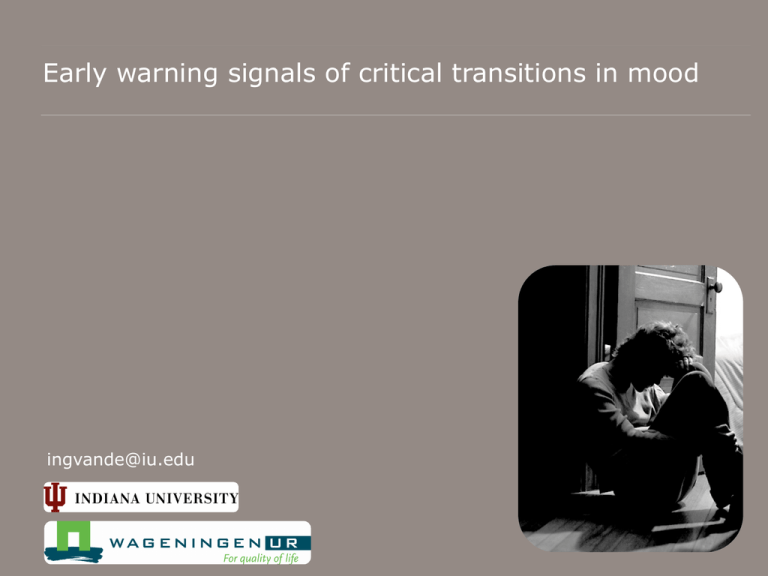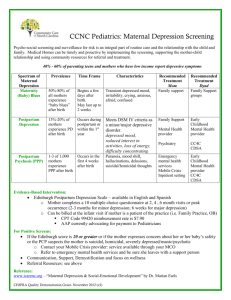Early warning signals of critical transitions in mood
advertisement

Early warning signals of critical transitions in mood ingvande@iu.edu Thanks to: • Marieke Wichers Dep. of Psychiatry and Psychology, RU Groningen • Angelique Cramer Dep. of Psychology, VU Amsterdam • Denny Borsboom Dep. of Psychology, VU Amsterdam • Ken Kendler Dep. of Psychiatry, Virginia Commonwealth University • Johan Bollen Center for complex networks and systems research, Indiana University • Marten Scheffer & Egbert van Nes Department of Environmental Sciences, Wageningen UR ?? • EssenOal characterisOcs of mental disorders? Psychological, neurological, geneOc.. Medical disease Alex Problems: • Headaches • ForgeTulness • Foggy eyesight Brain scan Diagnosis: • Brain tumor Treatment: • Surgery • Chemotherapy Mental disorders as medical disease Jenny Problems: • Problems sleeping • Depressed mood • Lack of interest DSM symptom check Diagnosis: • Major depression Treatment: • Therapy • AnOdepressants • MD is not an empirically idenOfiable enOty which can be treated directly (e.g. like Down syndrome or cancer) • No lab test for MD (e.g. 3rd chromosome, tumor) Medical disease model RelaOon between Major Depression and its observable symptoms according to the medical disease model Network approach Network of Major Depression and General Anxiety Syndrome symptoms based on correlaOons in the NaOonal Comorbidity Survey ReplicaOon data Symptoms could correlate because they are causally linked, instead of symptoms of a single disease Individual differences The network view allows us to define individual differences in terms of connection strengths (and thus individual paths to disorder): Affected by e.g.: • GeneOc factors • Hormones • Life events • Culture • etc.. ?? • Kendler et al. essenOally propose to view mental disorders as a\ractors in a large complex dynamical system Mood state Depression as a tipping point? Slow driver (e.g. stress) Small perturbation (e.g. upsetting phone call) Worrying Depressed Social mood isolation Indications of positive feedbacks Mood-­‐related factors: R = relaxed C = cheerful E = pleasant event S = sad F = fearful W = worry Early warning signals illustrated with a model describing mood dynamics anxious - cheerful sad + - - + - content Temporal data!! ESM: Experience Sampling Method 2 populations: ● General (without diagnosis depression) (n=535) ● Depressed (with diagnosis depression) (n=93) ‘beep’ Emotion Current state (1-7) Content … Satisfied … Anxious … Sad … 6 consecutive days, 10 times a day (7:30 - 22:30) Monitoring of follow-up course depressive symtoms Results General population closer to depression: ● Higher autocorrelation and variance of negative emotions Depressed population closer to recovery: ● Higher autocorrelation and variance of positive emotions Results General population closer to depression: ● Higher autocorrelation and variance of negative emotions ● Higher correlation between emotions Depressed population closer to recovery: ● Higher autocorrelation and variance of positive emotions ● Higher correlation between emotions Emotional Inertia Emotional inertia “refers to the degree to which a person’s current emotional state is predicted by their prior emotional state, reflecting how much it carries over from one moment to the next” Increased emotional inertia predictive of onset of depressive disorder Individual-level Wichers et al. under review Individual-level Wichers et al. under review Phase 1 (before experiment) Phase 2 (no anti-depr reduction) Phase 3 (anti-depr reduction) Phase 4 (before shift) Conclusions depression experiments Increased autocorrelation, variance, and correlation between emotions indicative for proximity ‘transition’ towards depression, and towards healthy state 1) Indication of positive feedbacks, 2) abrupt shifts, and 3) early warning signals suggest that depression and healthy state are alternative stable states.. .. and transitions between them are critical transitions/ tipping points Our results strengthen the network view of mental disorders Circumvent full understanding, but still improve ability to anticipate clinically relevant mood shifts Future issues .. What do the many roads to developing mental disorders look like? What sort of genetic/biological, psychological, and environmental factors govern individual differences in the strength of connections between symptoms? Replication of individual-level experiment (currently n=1) Causal links between symptoms? Convergent cross-mapping.. How can the theory of early warning signals help in targeting and evaluating therapeutic interventions? Mood tracking apps, rely on self-assessment Tracking mood in social media updates Twitter: “I was diagnosed bipolar” or “I was diagnosed depression” Sentiment analysis from short texts Social tipping points.. early warning signals Small perturbation (e.g. local uproar) Peerpressure # Active individuals Recognition Thank you ingrid.vandeleemput@wur.nl Network approach Network of Major Depression and General Anxiety Syndrome symptoms based on putaOve causal relaOons between symptoms The model ESM: Experience Sampling Method The four emotions were a-priori chosen to represent each quadrant of the affective space: Valence negaOve posiOve anxious cheerful high Arousal sad content low





